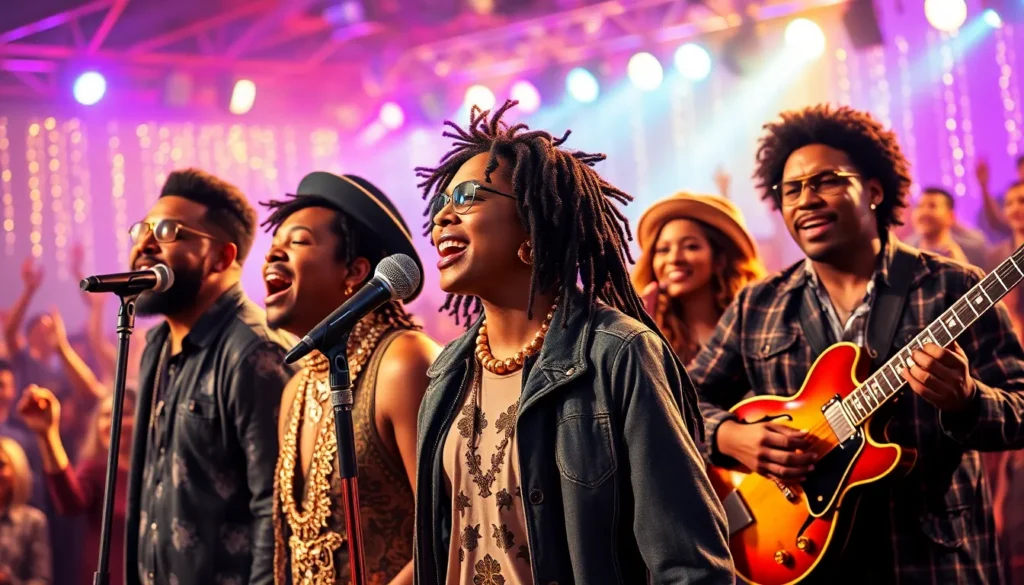Table of Contents
ToggleR&B music has a rich history that resonates deeply with listeners, blending soulful melodies with heartfelt lyrics. Over the decades, this genre has evolved, showcasing a diverse array of artists who bring their unique flair to the scene. From classic crooners to contemporary chart-toppers, R&B albums have consistently pushed boundaries and defined musical trends.
In recent years, the genre has experienced a resurgence, captivating a new generation of fans. With its roots in rhythm and blues, modern R&B incorporates elements of hip-hop, pop, and electronic music, creating a sound that’s both fresh and familiar. This article explores some of the most influential R&B albums that have shaped the genre, highlighting their impact on music and culture. Whether you’re a lifelong fan or just discovering the magic of R&B, there’s something here for everyone.
Overview of R&B Albums
R&B albums showcase the genre’s evolution through compelling storytelling and emotive performances. Key releases from pioneering artists like Ray Charles and Aretha Franklin set the foundation for R&B’s heartbeat, combining elements of gospel, blues, and jazz. These foundational albums not only influenced subsequent generations but also helped establish R&B as a major force in popular music.
Noteworthy modern R&B albums reflect the genre’s adaptability. Artists such as Beyoncé, Frank Ocean, and SZA incorporate contemporary themes and innovative production techniques. Their works blend traditional R&B elements with hip-hop and pop influences, appealing to a broad audience. This fusion revitalizes the genre, attracting new fans while honoring its rich heritage.
Significant R&B albums typically explore themes of love, heartbreak, and social issues. Through powerful lyrics and soulful arrangements, artists convey complex emotions, connecting deeply with listeners. Iconic albums like Marvin Gaye’s “What’s Going On” and Whitney Houston’s “The Bodyguard” soundtrack highlight R&B’s capacity for addressing societal concerns alongside personal narratives.
The impact of R&B albums extends beyond music charts. These works often serve as cultural touchstones, influencing fashion, dance, and art. The genre’s unique ability to merge personal experiences with broader cultural movements solidifies its lasting relevance in today’s music landscape.
Evolution of R&B Albums

R&B albums have undergone significant transformations since their inception, shaped by various influences and cultural shifts. This genre’s development showcases a blend of traditional roots and modern innovations.
Early Influences
Early R&B music emerged in the 1940s, marked by the fusion of gospel, blues, and jazz. Pioneers like Ray Charles and Aretha Franklin created rich, emotive sounds that resonated with audiences. They harnessed powerful vocal techniques and storytelling, laying the groundwork for future R&B styles. Notable albums from this era include Charles’ “Modern Sounds in Country and Western Music” and Franklin’s “I Never Loved a Man the Way I Love You.” These works emphasized personal narratives and emotional depth, essential elements that continue to characterize the genre.
Modern Transformations
Modern R&B albums reflect a dynamic evolution, integrating diverse musical styles such as hip-hop, pop, and electronic influences. Artists like Beyoncé, Frank Ocean, and SZA exemplify this trend, pushing boundaries through innovative production techniques and contemporary themes. Noteworthy albums include Beyoncé’s “Lemonade,” which explores empowerment and social justice, and Ocean’s “Blonde,” addressing themes of identity and introspection. The subject matter in modern R&B often delves into complex emotions, relationships, and sociopolitical issues, maintaining relevance in today’s music landscape while appealing to new generations of listeners.
Notable R&B Albums
R&B albums play a crucial role in defining the genre, showcasing its emotional depth and cultural significance. This section highlights both classic and contemporary R&B albums that have left a lasting impact.
Classic R&B Albums
Classic R&B albums established the foundation of the genre, blending gospel, blues, and jazz influences. Notable examples include:
- Ray Charles – Modern Sounds in Country and Western Music: This 1962 album broke barriers, introducing R&B to country music, featuring hits like “I Can’t Stop Loving You.”
- Aretha Franklin – I Never Loved a Man the Way I Love You: Released in 1967, this album showcased Franklin’s powerful vocals and emotional delivery, with standout tracks like “Respect.”
- Marvin Gaye – What’s Going On: This 1971 landmark album tackled social issues and personal struggles, with the title track becoming an anthem for change.
- Otis Redding – Otis Blue: Otis Redding Sings Soul: This 1965 release highlighted Redding’s distinctive voice and poignant songwriting, featuring classics like “I’ve Been Loving You Too Long.”
Contemporary R&B Albums
- Beyoncé – Lemonade: This 2016 visual album melds personal narratives with socio-political commentary, featuring tracks like “Formation” and “Sorry.”
- Frank Ocean – Blonde: Released in 2016, this album redefined R&B with its experimental sound and introspective lyrics, highlighted in songs like “Nikes” and “Ivy.”
- SZA – Ctrl: This 2017 debut album explores themes of love and identity, resonating with listeners through tracks like “Love Galore” and “The Weekend.”
- H.E.R. – H.E.R.: This self-titled album, released in 2017, showcases H.E.R.’s soulful voice and storytelling ability, featuring songs like “Focus” and “Best Part.”
Impact of R&B Albums on Music Culture
R&B albums significantly influence music culture by shaping genres and trends. They serve as a foundation for artists in hip-hop, pop, and electronic music, showcasing the genre’s versatility. The soulful melodies and relatable narratives inspire countless musicians, pushing boundaries in artistic expression.
R&B albums impact fashion trends through iconic artists’ styles. For instance, Beyoncé’s fashion statements in “Lemonade” resonate widely, influencing both streetwear and high fashion. Frank Ocean’s unique aesthetic in “Blonde” promotes individuality and authenticity, encouraging fans to express themselves through personal style.
R&B albums also affect dance culture. Tracks from artists like Usher and Chris Brown spark dance crazes, impacting choreography in schools and social settings. The rhythmic beats and smooth vocals inspire a new generation of dancers, fostering creativity and movement.
Social commentary in R&B albums addresses pressing societal issues. Marvin Gaye’s timeless work in “What’s Going On” highlights the struggles of the civil rights movement. Contemporary artists continue this tradition, with SZA’s “Ctrl” exploring themes of identity and empowerment, encouraging discourse around mental health and self-acceptance.
R&B albums resonate on a personal level, facilitating emotional connections among listeners. The genre’s exploration of love, heartbreak, and resilience captivates audiences, allowing them to find solace in shared experiences. This emotional depth not only strengthens fan loyalty but also enhances the cultural significance of R&B music.
R&B albums play a crucial role in shaping music culture, influencing fashion, dance, social issues, and personal connections. Their impact reaches far beyond sound, solidifying R&B’s relevance and importance in today’s music landscape.
R&B albums continue to be a powerful force in music, bridging generations and cultures. Their ability to blend personal storytelling with broader social themes ensures they remain relevant and impactful. As artists push the boundaries of the genre, they not only honor its rich history but also pave the way for innovative sounds that resonate with today’s audiences. The emotional depth and cultural significance of R&B albums will undoubtedly keep them at the forefront of the music scene for years to come. Fans can look forward to the evolution of this beloved genre, knowing it will always reflect the complexities of life and love.







